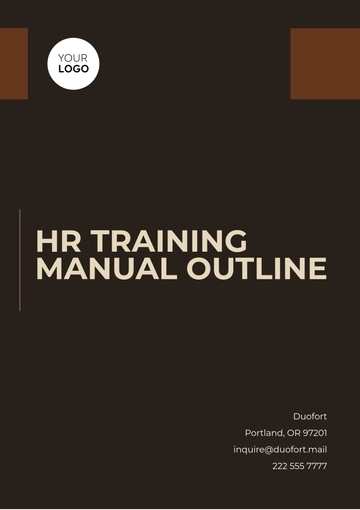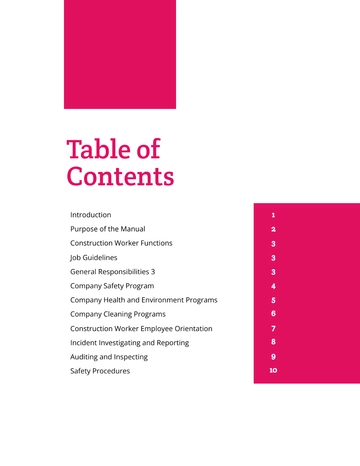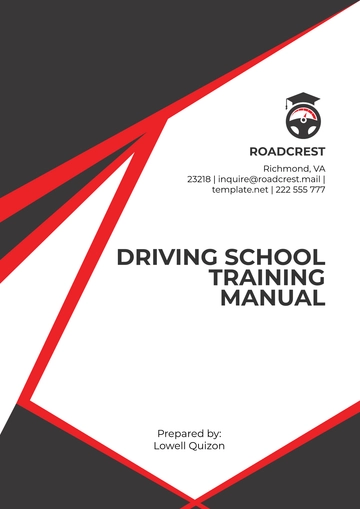Free Sales Training Manual for Trade Show Booth Staff

Show Booth Staff
Introduction
Trade shows serve as a powerful platform for our organization to showcase our product offerings, foster industry relationships, and, most critically, engage with potential clients. Your role as a booth staff member is pivotal to the success of our company's objectives in these events.
This manual is not just a collection of guidelines; it is an integral resource aimed at harmonizing our brand representation, facilitating client engagement, and boosting sales performance. Please read it carefully, as it contains in-depth information and best practices to equip you with the skills and knowledge to excel in your role.
Objective
To meet these objectives, this manual provides a structured approach to your roles and responsibilities, preparation strategies, and booth etiquette. By internalizing these objectives and following this guide rigorously, you will contribute significantly to our company's success at trade shows.
Brand Awareness: To elevate our brand's profile by maximizing visibility and resonance amongst a targeted audience, including industry stakeholders, consumers, and media outlets.
Lead Generation: To proactively seek, identify, and engage with prospective clients and strategic partners. The aim is not just to capture contact details, but to initiate meaningful interactions that qualify leads for subsequent, targeted marketing campaigns and sales follow-ups.
Customer Relationship: To solidify and extend our relationships with existing clients and business partners through personalized engagement. This involves attending their immediate needs and understanding their long-term goals and how our products or services can facilitate them.
Market Intelligence: To actively gather and analyze data on market trends, consumer behaviors, and competitor initiatives. The intent is to transform these insights into actionable strategies that benefit our product development, marketing, and overall business roadmap.
Revenue Growth: To ultimately achieve a substantial return on investment, both in the short-term and long-term. This encompasses immediate sales conversions at the event, as well as cultivating long-lasting business relationships that generate sustainable revenue streams.
By aligning your actions with these objectives, you play a critical role in the overall strategy of [Your Company Name] at each trade show. Your preparedness and performance can directly impact the company's bottom line and market standing.
Roles and Responsibilities
In a trade show setting, every staff member has a distinct role to play, contributing to the collective success of [Your Company Name]'s objectives. The following table offers an expanded outline of the various roles you might assume.
Role | Responsibilities |
|---|---|
Booth Manager |
|
Product Demonstrator |
|
Sales Representative |
|
Customer Service Representative |
|
Each role is indispensable to our trade show operations and contributes uniquely to our objectives of brand awareness, lead generation, customer relationship enhancement, market intelligence gathering, and revenue growth. Every team member must understand not only their own responsibilities but also how their role interfaces with others.
Preparation Checklist
Prior to the trade show, comprehensive preparation is key to ensuring a smooth and successful event. This section is designed to offer a structured, step-by-step guide to ready yourself and the team for the multitude of tasks and interactions that you will encounter.
Checklist Item | Due Date |
|---|---|
Review Product Catalog | Two weeks before event |
Memorize FAQs | One week before event |
Understand Roles and Responsibilities | Immediate |
Familiarize with Booth Layout | One day before event |
Equipment Check | One day before event |
Initial Team Meeting | One week before event |
Lead Management System Training | One week before event |
Dress Rehearsal | Two days before event |
Stock Marketing Collateral | One day before event |
Review Product Catalog: Go beyond basic familiarity; become an expert on our product line. Understand the unique features, benefits, and pricing of each product. Additionally, be aware of how our offerings compare to competitors' products and be prepared to articulate this to potential clients.
Memorize FAQs: Thoroughly study and internalize the Frequently Asked Questions and their corresponding answers. Be prepared to offer concise yet comprehensive responses to these common queries.
Understand Roles and Responsibilities: Absorb the full scope of your specific role, its responsibilities, and how it contributes to the broader objectives of [Your Company Name]'s participation in the trade show. Grasp how your tasks overlap or interact with those of your team members to foster seamless cooperation and ensure that no operational gaps occur.
Familiarize with Booth Layout: Walk through the actual or planned booth setup prior to the event. Understand where each product or service will be showcased, where marketing collateral is stored, and where technical setups like AV equipment are located.
Equipment Check: Conduct a meticulous inspection of all booth equipment, including digital displays, laptops, audio systems, and demonstration setups. Verify their operational status and functionality to preempt any technical issues that could disrupt the booth's operations.
Initial Team Meeting: Attend a comprehensive kickoff meeting that covers not only the objectives and roles but also lays out the performance metrics by which success will be measured. This is an opportunity to clarify any questions, establish communication protocols, and align the team towards common goals.
Lead Management System Training: Familiarize yourself with the lead capturing and management system to be used. Learn its features, data entry protocols, and troubleshooting steps.
Dress Rehearsal: Take part in a full-scale dry run of booth activities, from setup to takedown. Use this rehearsal to identify potential bottlenecks, equipment failures, or role-based confusions that can be preemptively addressed.
Stock Marketing Collateral: Perform an inventory check to confirm the availability of essential marketing materials, such as brochures, business cards, and promotional giveaways. Ensure they are in sufficient quantities to last the duration of the trade show and are aligned with the brand and message we aim to convey.
Following this checklist will not only facilitate a seamless experience for visitors but also equip you, the staff, with the confidence and resources to effectively represent [Your Company Name]. Adhering to these preparation steps will serve to maximize our achievement of key objectives such as brand awareness, lead generation, customer relationship enhancement, market intelligence gathering, and revenue growth.
Booth Etiquette
The way each staff member conducts themselves at the booth significantly impacts [Your Company Name]'s brand perception and overall trade show success. Below are expanded guidelines that cover different facets of booth conduct.
Professional Appearance: Adherence to [Your Company Name]'s dress code is non-negotiable. Ensure your attire is not only within company guidelines but also immaculately clean and ironed. Your appearance should align with the brand image we aim to project, serving as a visual representation of our commitment to professionalism and quality.
Punctuality: Be present at the booth at least [30 minutes] before your scheduled shift begins. Use this time to familiarize yourself with any changes in the booth layout, review product information, and mentally prepare for the day's activities. Punctuality ensures a seamless transition between shifts and signifies your commitment to the team's overall performance.
Body Language: Your nonverbal cues speak volumes. Maintain an open and inviting posture, make consistent eye contact with visitors, and keep a genuine smile on your face. Avoid actions that might signal disinterest or impatience, such as crossing your arms or constantly checking your watch. Your body language can greatly influence a visitor's first impression and level of comfort.
Engaging Visitors: Take a proactive stance in initiating dialogue with booth visitors. Politely approach individuals who seem interested in the booth and offer to assist them, rather than waiting for them to come to you. This proactive behavior can maximize lead generation and create more opportunities for meaningful interactions.
Handling Queries: Actively listen to questions from visitors, providing clear, concise, and accurate answers. If a query falls outside your expertise, gracefully refer the individual to a colleague better suited to address their concerns. The goal is not just to provide information but to build trust and credibility.
Use of Technology: Limit the use of personal devices to emergencies only. Your primary focus should be booth activities and engaging with visitors. If technology is required for a booth task, like scanning a QR code or entering data into a lead management system, use it efficiently and professionally.
Data Capture: Accurate and prompt data capture is critical for future sales and marketing activities. Ensure that every meaningful interaction leading to the exchange of contact details is swiftly and precisely entered into the lead management system. Confirm the accuracy of the information with the visitor, when possible, to mitigate future communication issues.
Handling Materials: Keep all marketing materials, such as brochures and promotional items, organized. These should be easily accessible yet only distributed when relevant to enhance the conversation and deepen visitor engagement. This prevents wastage and ensures that materials go to genuinely interested parties.
End-of-Day Procedures: After each day's activities, participate actively in the booth teardown and storage procedures. Follow the directions provided for proper packing and inventory management. Efficient teardown aids in faster exit strategies and ensures that all materials are secured and accounted for.
By internalizing and implementing these etiquette guidelines, each staff member becomes a vital component in achieving [Your Company Name]'s trade show objectives. Excellence in these aspects of booth conduct significantly aids in building brand awareness, driving lead generation, fostering customer relationships, collecting market intelligence, and ultimately, growing revenue.
FAQs
Understanding and articulating clear, concise answers to commonly posed questions is crucial for establishing credibility and fostering visitor engagement. Below are the frequently asked questions you may encounter at the trade show:
What does [Your Company Name] specialize in?
“[Your Company Name] specializes in offering a diverse range of high-quality [Product Name]. We focus on ensuring value and satisfaction for our clientele.”
Do you offer any trade show discounts?
“Yes, we are offering a special [15%] discount for purchases made during the trade show. This is an exclusive opportunity to acquire our products/services at a reduced price.”
What is your lead time for delivery?
“Our standard lead time for delivery is [3 days], but expedited options are available at an additional cost.”
How can I stay updated with [Your Company Name]?
“You can stay updated by subscribing to our newsletter, following us on [Your Company Social Media], or regularly visiting our website at [Your Company Website] for the latest news and updates.”
What is your return policy?
"We offer a [6-month] return policy, provided the product is returned in its original condition. Please review our full return policy on our website or in the literature available at this booth.”
By mastering the answers to these frequently asked questions, booth staff not only equip themselves with the ability to handle inquiries confidently but also represent [Your Company Name] in a manner that aligns with our commitment to customer service and transparency.
Conclusion
The success of [Your Company Name] at any trade show hinges on the meticulous preparation, professionalism, and collaborative effort of each booth staff member. By internalizing and implementing the guidelines and best practices outlined herein, you contribute significantly to achieving our overarching goals of brand awareness, lead generation, customer relationship building, market intelligence gathering, and revenue growth.
Thank you for your commitment and dedication to making our participation in trade shows a fruitful endeavor. We look forward to a successful event and the promising opportunities it will undoubtedly bring.
- 100% Customizable, free editor
- Access 1 Million+ Templates, photo’s & graphics
- Download or share as a template
- Click and replace photos, graphics, text, backgrounds
- Resize, crop, AI write & more
- Access advanced editor
Empower your team with Template.net's Sales Training Manual for Trade Show Booth Staff Template. This customizable and editable template equips booth staff with the necessary skills and knowledge to excel at trade shows, from engaging potential clients to closing deals. Personalize your training content with our Ai Editor Tool, optimizing performance and effectiveness on the show floor.





























